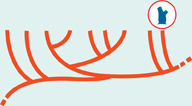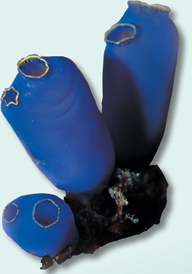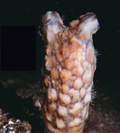Nonvertebrate Chordates


Tunicates are chordates named for the colorful tunic-like covering the adults have. As larvae, tunicates have all the characteristics of chordates, as well as bilateral symmetry, but as adults, they look very, very different.
KEY CHARACTERISTICS
The nonvertebrate chordates are the only chordates that lack a backbone. Like other chordates, they have a nerve cord, notochord, pharyngeal pouches, and a tail at some point during development. They are coelomate deuterostomes. The two subphyla, tunicates and lancelets, differ significantly.
Feeding and Digestion Filter feeders; tunicates—in most, water carrying food particles enters through an incurrent siphon; food is strained out in the pharynx and passed to the digestive system; lancelets—mucus in the pharynx catches food particles carried in by water, which are then carried into digestive tract
Circulation Closed; tunicates—heart pumps blood by “wringing out,” and flow periodically reverses direction; lancelets—no heart, but blood vessels pump blood through body in one direction
Respiration Tunicates—gas exchange occurs in the gills and across other body surfaces; lancelets—through pharynx and body surfaces
Excretion Tunicates—most through excurrent siphon; lancelets—flame cells in nephridia release water and nitrogenous wastes into the atrium and out through an opening called an atriopore
Response Cerebral ganglion, few specialized sensory organs; tunicates—sensory cells in and on the siphons and other internal surfaces help control the amount of water passing through the pharynx; lancelets—a pair of eyespots detect light
Movement Tunicates—free-swimming larvae, but most are stationary as adults; lancelets—no appendages: they move by contracting muscles paired on either side of the body
Reproduction Tunicates—most sexual and hermaphroditic with external fertilization, but some reproduce by budding; most have free-swimming tadpole-like larvae that metamorphose into adults; lancelets—sexual with external fertilization
Eco•Alert
Out-of-Control Tunicates
You've never heard of them, but Asian stalked tunicates are disrupting marine ecosystems in Washington State; Prince Edward Island, Canada; and elsewhere. Tunicate larvae are carried in the ballast water of freight ships and discharged wherever the ships make port. There, away from their usual predators, the tunicates grow out of control, smothering shellfish beds and covering boats, docks, and underwater equipment. Researchers are still trying to figure out how to control them.

Asian Stalked Tunicate
Table of Contents
- Formulas and Equations
- Applying Formulas and Equations
- Mean, Median, and Mode
- Estimation
- Using Measurements in Calculations
- Effects of Measurement Errors
- Accuracy
- Precision
- Comparing Accuracy and Precision
- Significant Figures
- Calculating With Significant Figures
- Scientific Notation
- Calculating With Scientific Notation
- Dimensional Analysis
- Applying Dimensional Analysis




